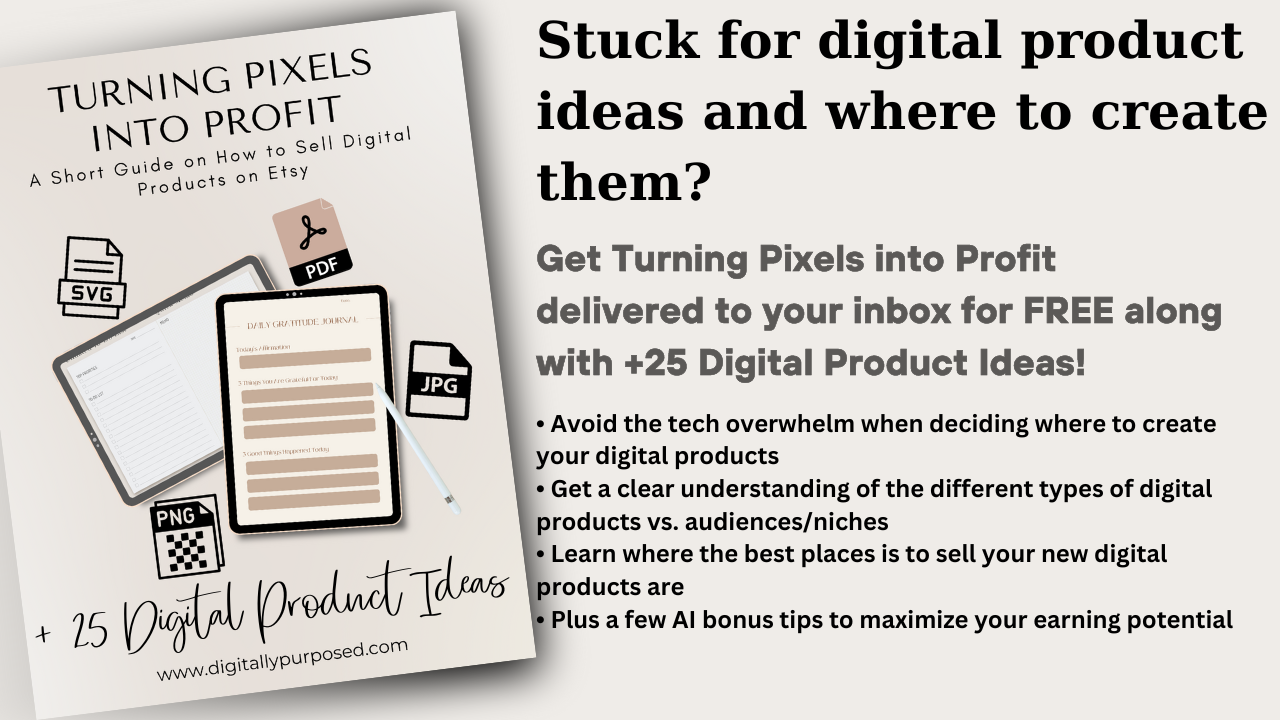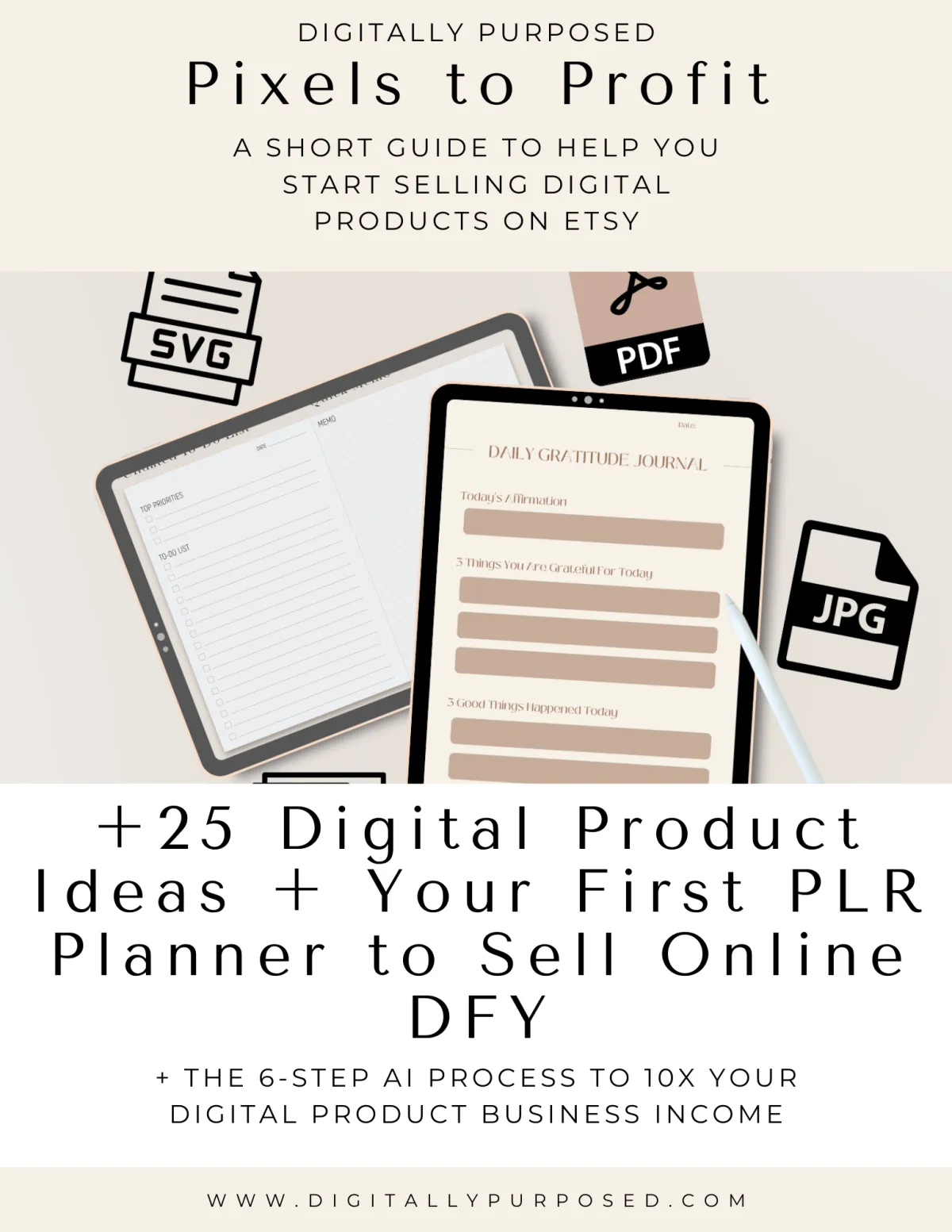BLOG
How To Sell Digital Products Online

How to Sell High Ticket Digital Products on Etsy
So, what is a high-ticket digital product? High-ticket digital products include website templates, notion templates, brand kits, budget trackers, digital planners, and so much more.
The overlapping quality is that these digital products deliver a TON of value to the customer, making them a product worth a higher price point of $10, $15, $20, or even $30+.
(This post contains affiliate links and you can read the full disclosure here)
Take a look at what my search for “Notion templates” brought up on Etsy:

Some of the pre-sale prices are as high as $46 to $54! Even on sale, the least expensive product brings in over $7 a sale.
High-ticket products are excellent digital product offerings because you can sell less and still make a lot of money, compared to $1 digital printables, where you’d need to sell 1,000 products each month to hit your goal of earning $1,000 in revenue. In contrast, you’d only need to sell 40 for a $25 digital product to make the same amount!
Now, convincing someone to buy a $1 product might be easier than a $25 one, but the benefit of the high-ticket items automatically gives them a considerable appeal.
The hook? All of these high-ticket items promise to help the buyer accomplish big things! For example, a life planner to organize and manage your whole life or a brand kit to revamp your branding for the better (and help you make more money).
Here are the top steps you need to take to sell high-ticket digital products on Etsy:
Determine What High-Ticket Digital Products You’re Going to Sell
Many of these digital products require some skill to craft, whether that’s the ability to create templates in Notion or the know-how to create a cohesive brand kit.
Consider your skillset.
Do you have a background in website design? Thoughtful website templates are popular because many people don’t have the skills or time to design a website.
Do you love using Notion or Canva? You can create endless numbers of life management, budget, social media, or small business organization templates with these!
Have a good head for business or marketing? Look into brand kits or informative e-books.
Do you enjoy writing? Craft an e-book, email marketing, or writing-based templates like journaling prompt workbooks.
An easy way to brainstorm ideas on Etsy is by looking at search results. Type in a general term related to your idea, such as “workbook,” and take note of the most popular search results.

When I clicked on “workbook template,” countless ideas popped up from workbook templates for fiction writers, coaches, small business owners, Canva challenges, and even reinvention guides. Use Etsy’s search engine, and you’ll never run out of unique ideas!
Product and Market Research
After brainstorming ideas for what kind of products you’d like to sell, dive into product and market research to determine how competitive this product is and if there is enough demand to make producing this product worthwhile.
The ideal product has moderate to high search volume but lower competition, which means plenty of people are interested in your product, but fewer sellers are in this niche.
I recommend tools like EverBee for Etsy research. You can quickly find high-demand product ideas and even get an idea of what top sellers make each month on their products. This research is a great way to assess the niche’s potential before you commit.
Next, study your competition. Search for similar products on Etsy and look up what your competitors are selling, their titles, descriptions, products, social media, and anything else you can find to gain insight into their products and niche. I recommend paying particular attention to similar products' price points and value propositions.
You can even purchase several of your competitors’ products to get a feel for how they work and any extras they include, such as a link to a video tutorial. Use what you learn to inspire your digital product.
Consider Your Target Audience
Let’s say you’ve determined that you want to sell Notion templates. Next, you’ll need to study popular Notion templates and determine which kind of template and style you’re interested in for your target audience.
Is your target audience college students organizing a busy class load?
Are you creating a life admin dashboard for moms keeping track of their families’ lives, from appointments to medical information to grocery lists?
Or, you may like the aesthetic Notion templates designed toward “That Girl” or “Female Entrepreneurs.”
Look for Etsy shops with similar target audiences and get a feel for what products are selling well. Keep your target audience front of mind at all times to ensure your product is tailor-made to address their pain points above all else.

Create Your Product
If you’re making something like a Notion or Canva template, it’s obvious what platform you’ll need to start with, but other products, like e-books, have many options for how you can make them.
Identify the platform or platforms you’ll need to make your digital product. Then, depending on your current skill level, play around with the platform and learn as much as possible about it. I recommend watching YouTube tutorials, as these can be extremely helpful! You might even be able to find tutorials specific to the platform and type of product you’re interested in making, saving you a lot of time.
My biggest advice when creating products is to focus on quality over quantity, but NOT to the point that you procrastinate by continuously “perfecting” your product and never listing it.
I’ve seen too many of my students get lost in analysis paralysis or their perfectionism, leading to them never launching (or massively delaying) their Etsy shop. The only way your business can thrive is by taking those first and, yes, scary steps of listing your products.
With that said, you want your products to be as high-quality as possible so that customers become repeat customers who share your creations with others and want to follow you on social media.
Create Mockups
Customers on Etsy won’t stop and read your in-depth product descriptions unless you pique their interest with a high-quality mockup of your product.
Digital mockups show how the final product looks and functions, allowing customers to see the product's value in a quick snapshot.
Before making mockups, stop and consider what the purpose of your product mockup is.
What are your product’s key features?
What is the most aesthetically pleasing part of your product that you can show off?
What is your target audience trying to accomplish with your product?
Keep these in mind as you develop your mockups. Then, choose a design tool that fits your needs. I use and recommend Canva. You can also purchase digital mockup templates on Etsy if you’re short on time.
After creating your mockup, ask a friend, family member, or partner to look it over. Can they immediately tell what the value of your product is and how it works simply by looking at the photos with no additional context?
Remember, potential buyers will be scrolling through lots of product listings, so your mockup needs to be eye-catching to make them stop and take a closer look at your product and description.
I also recommend creating a short video trailer and tutorial for your product. The video doesn’t have to be long and drawn out, but it can quickly show how to use the product, giving potential customers more confidence to purchase.
List and Optimize Your High-Ticket Digital Product
Using tools like EverBee and Etsy search, identify the best keywords for your product and include them in your title, tags, and product description. Include several long-tail keywords and variations of these keywords to maximize your chances of showing up in search.
Keep your title concise but informative. While you want to include relevant keywords, you don’t want your title to read like a robot wrote it. Your customers are human, so make sure the title is clear and descriptive and highlights unique features and selling points.
Often, including your target audience in the title is a great way to make it stand out.
For example, several brand kits below are specifically designed for real estate agents. The target audience is repeated in both the title and the image, making it immediately evident who this brand kit benefits.

Including your target audience clearly in the listing grabs your audience’s attention. Think of it this way: If you’re a realtor and search “brand kit” and see that several options are available specifically for realtors, you’ll be far more likely to click on those listings over a generic listing.
If your target audience is more of an aesthetic or a larger group, say moms in their 30s, that you can’t easily list in your title. Try conveying the benefit of your product instead.
For example, your title could be “Notion Template Family and Household” or “That Girl Ultimate Life Planner.”
Both titles don’t directly state an audience. But they have precise purposes to hook your audience based on their needs — managing a busy life and household or upgrading your life/appealing to women in their 20s and 30s with the “That Girl” trend.
Market Your Product
If you’ve made it to this section and you’re thinking, but wait, I don’t have an online audience, don’t worry!
I had no audience when I started, and I was able to build a six-figure digital products business on Etsy within a few months. You can, too!
Remember that many Etsy sellers built their business from the ground up without a preexisting audience. Everyone has got to start somewhere, and the sooner, the better.
Here are a couple of ideas to start marketing your product inexpensively:
Share your business with family and friends
Start business social media accounts and begin posting engaging content showcasing your products (use relevant hashtags for better visibility)
Begin building an email list immediately (this is something I wish I did! While it’s a long-term strategy, the value you reap from an email list is unmatched).
Participate in Etsy Seller Facebook Groups
Offer promotions and discounts
Create a cohesive brand image (Strong branding helps your products stand out and seem more professional)
Later on, you can experiment with Etsy ads or other marketing efforts, like building a website, but for now, stick to building momentum with your new shop. You don’t want to spread yourself too thin.
Continue to Build Off Successes
Listen to customer feedback about your product. While nobody wants to hear anything negative about something they worked hard on, constructive criticism can help you massively improve your products in the long run.
Customer feedback can even inspire other products when you read comments about what they wish a product had or didn’t have.
Next, build off your successes by creating multiple versions of the same product. You can often list digital products several times with simple tweaks, like changing the aesthetic.
For example, if you offer a Notion template in a beautiful blue, create an earthy green version with a minimalistic color scheme to appeal to different tastes.
Each new listing gives you one more chance to show up in search and snag a customer, so keep your store “fresh” by adding new products and varieties as often as possible while maintaining product quality.
Ready to learn even more about building a six-figure digital products business? Digitally Purposed, shares each step I took to create my six-figure digital product business from the ground up with no existing audience.
Our community, Digitally Purposed, is different from anything out there. Not only does it lay out a step-by-step guide to launching and marketing your digital products business and helping you overcome common misconceptions, it also has one of the best private support communities dedicated to helping you every step of the way.
Plus, we have weekly training on the most requested topics like marketing, design tutorials, niche research, along with live Q&A calls and new PLR products!
Just need some feedback? Personalized shop audits are also included!
Selling digital products online requires constant learning and we'd love to support you!

FREE DOWNLOAD
Stuck for Digital Product Ideas?
Grab this free list of 25 digital products (+ the 6-step AI process to 10x your digital product business income) and where to create and sell them here.
© Copyright 2024 Digitally Purposed - Privacy Policy - Terms of Service - Disclosure
The term "Etsy" is a trademark of Etsy, Inc. This course content is intended for use on Etsy.com but is not endorsed or certified by Etsy, Inc.
